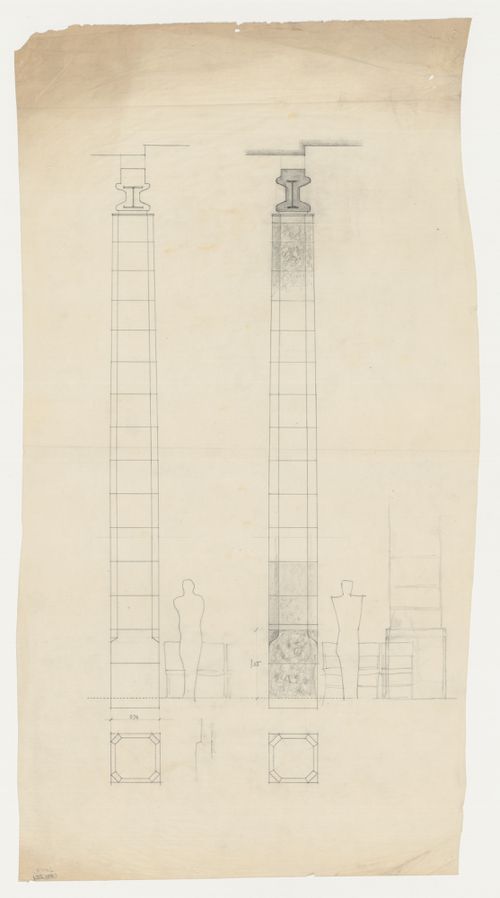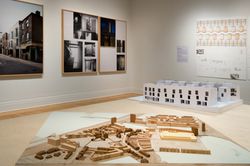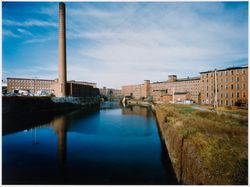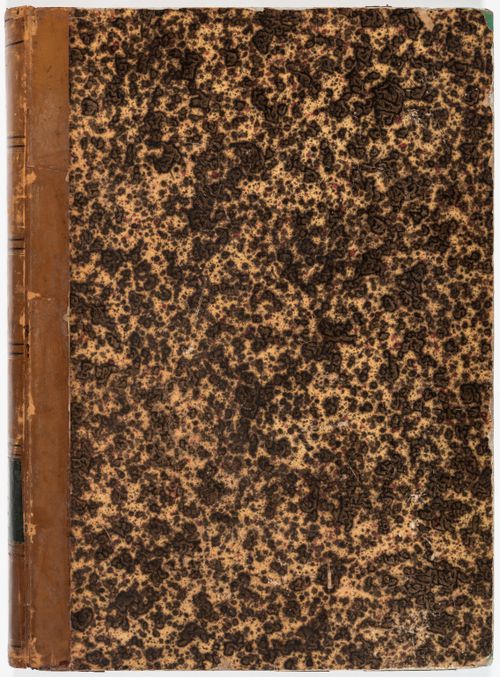Au cours des années soixante, les profondes transformations de Montréal en ont fait un archétype des grandes métropoles occidentales. À titre d’hôte de l’exposition universelle de 1967, Montréal a confirmé son statut de ville de l’avenir sur la scène internationale. Les années 60 : Montréal voit grand illustre les processus qui ont entraîné cette mutation. À travers des(...)
Salles principales
20 octobre 2004 au 11 septembre 2005
Les années 60 : Montréal voit grand
Actions:
Description:
Au cours des années soixante, les profondes transformations de Montréal en ont fait un archétype des grandes métropoles occidentales. À titre d’hôte de l’exposition universelle de 1967, Montréal a confirmé son statut de ville de l’avenir sur la scène internationale. Les années 60 : Montréal voit grand illustre les processus qui ont entraîné cette mutation. À travers des(...)
Salles principales
DR1994:0094
Description:
- The columns in this drawing have been drawn mechanically, while stylized human figures (to indicate scale) have been drawn freehand.
architecture, design d'intérieur
1935-1940
Elevations, a partial elevation and plans for columns for the Chapel of the Holy Cross, Woodland Crematorium, Woodland Cemetery, Stockholm, Sweden
Actions:
DR1994:0094
Description:
- The columns in this drawing have been drawn mechanically, while stylized human figures (to indicate scale) have been drawn freehand.
architecture, design d'intérieur
Cette exposition se consacre aux projets architecturaux récents de Stephen Taylor à Londres et de Ryue Nishizawa à Tokyo, qui proposent de nouvelles approches de la vie en milieu urbain. Perspectives de vie à Londres et à Tokyo imaginées par Stephen Taylor et Ryue Nishizawa marque la première présentation en Amérique du Nord des projets résidentiels de Taylor et Nishizawa(...)
Salles principales
14 mai 2008 au 26 octobre 2008
Perspectives de vie à Londres et à Tokyo imaginées par Stephen Taylor et Ryue Nishizawa
Actions:
Description:
Cette exposition se consacre aux projets architecturaux récents de Stephen Taylor à Londres et de Ryue Nishizawa à Tokyo, qui proposent de nouvelles approches de la vie en milieu urbain. Perspectives de vie à Londres et à Tokyo imaginées par Stephen Taylor et Ryue Nishizawa marque la première présentation en Amérique du Nord des projets résidentiels de Taylor et Nishizawa(...)
Salles principales
artéfacts, livres
DR1991:0021:001-002
Description:
- The calculator is made up of three discs, two moveable and one fixed. The bottom disc is printed with seven concentric scales and is rotated using the top knob. The middle disc is clear plastic imprinted with a single black line and is rotated using the upper right knob. The top disc is the fixed protective shield, imprinted with a red line. Following the instructions in the accompanying booklet, DR1991:0021:002, the compass can be manipulated to perform calculations and conversions in much the same manner as a slide rule.
architecture
early 20th century
Fowler "12-10" calculator in a leather case, with instruction booklet
Actions:
DR1991:0021:001-002
Description:
- The calculator is made up of three discs, two moveable and one fixed. The bottom disc is printed with seven concentric scales and is rotated using the top knob. The middle disc is clear plastic imprinted with a single black line and is rotated using the upper right knob. The top disc is the fixed protective shield, imprinted with a red line. Following the instructions in the accompanying booklet, DR1991:0021:002, the compass can be manipulated to perform calculations and conversions in much the same manner as a slide rule.
artéfacts, livres
early 20th century
architecture
dessins
DR1988:0433:043
Description:
- This drawing shows elevations of the south facade, towards the east end of the building, and a section through the wall at the drawing room balcony. The subject was identified by comparison with DR1988:0433:011, an elevation of the south facade. - This drawing was not completed; it lacks the titles present on other drawings in the group DR1988:0433:001 - DR1988:0433:045. Several elements, such as the chimneys, were drawn in graphite and not completed with pen and ink. - One of a group of working drawings for William Burn's October 1849 project for Fonthill House, Wiltshire, a country house designed in the Jacobethan style. This group represents only one of the projects that Burn proposed for Fonthill House; the final project, executed in 1856, was much smaller (Walker, 31, illustrated in Hitchcock, vol. 2, fig. VIII 31). Drawings include plans, elevations, and sections, as well as full-scale drawings of masonry details. Approximately half of the drawings are part of a numbered series from one to twenty-two, while the other drawings, mostly masonry details, were not numbered. These latter drawings are not as carefully finished, and a few are incomplete.
architecture
October 1849
Elevations and a section for the east side of the south elevation, and a section for the south wall through the drawing room balcony, Fonthill House
Actions:
DR1988:0433:043
Description:
- This drawing shows elevations of the south facade, towards the east end of the building, and a section through the wall at the drawing room balcony. The subject was identified by comparison with DR1988:0433:011, an elevation of the south facade. - This drawing was not completed; it lacks the titles present on other drawings in the group DR1988:0433:001 - DR1988:0433:045. Several elements, such as the chimneys, were drawn in graphite and not completed with pen and ink. - One of a group of working drawings for William Burn's October 1849 project for Fonthill House, Wiltshire, a country house designed in the Jacobethan style. This group represents only one of the projects that Burn proposed for Fonthill House; the final project, executed in 1856, was much smaller (Walker, 31, illustrated in Hitchcock, vol. 2, fig. VIII 31). Drawings include plans, elevations, and sections, as well as full-scale drawings of masonry details. Approximately half of the drawings are part of a numbered series from one to twenty-two, while the other drawings, mostly masonry details, were not numbered. These latter drawings are not as carefully finished, and a few are incomplete.
dessins
October 1849
architecture
Pendant trois ans, Serge Hambourg a pris plus de 400 photographies de manufactures historiques de la Nouvelle-Angleterre commandées par le CCA. Ces formes architecturales, représentées dans leur environnement, mettent en valeur la beauté austère des intérieurs et des extérieurs. Les photos tracent l’évolution de ce type de bâtiment. Ces images montrent des structures de(...)
Antichambre de la salle octogonale
6 décembre 1989 au 11 février 1990
Manufactures de la Nouvelle-Angleterre : photographies de Serge Hambourg
Actions:
Description:
Pendant trois ans, Serge Hambourg a pris plus de 400 photographies de manufactures historiques de la Nouvelle-Angleterre commandées par le CCA. Ces formes architecturales, représentées dans leur environnement, mettent en valeur la beauté austère des intérieurs et des extérieurs. Les photos tracent l’évolution de ce type de bâtiment. Ces images montrent des structures de(...)
Antichambre de la salle octogonale
Projet
AP156.S3.SS1.D28
Description:
Le dossier documente le projet de Pierre Jeanneret d'un bâtiment démontable pour les dessinateurs de la Société centrale de alliages légers (SCAL) réalisé à Issoire en France, en 1940. Jeanneret collabore avec Jean Prouvé pour la réalisaition de ce projet. Le bâtiment consiste en un pavillon à portique axiale sur deux étages, la première structure à portique axial réalisée par Jean Prouvé. Ce projet à été présenté dans la publication spéciale "Solutions d'urgence" de la revue "Architecture d'aujourd'hui" publiée en 1945. Le dossier contient une photographie du bâtiment. File documents Pierre Jeanneret's project for a dismontable building for the offices of the draftsman of the Société centrale de alliages légers (SCAL) in Issoire, France, in 1940. Jeanneret works on this projet in collaboration with Jean Prouvé. The building consists in a two-storey pavilion with an axial gantry, the first structure of the type realized by Jean Prouvé. This project was presented in the special publication "Solutions d'urgence" of the serial "Architecture d'aujourd'hui" published in 1945. The file contains a photograph of the building.
1940
Bureau des dessinateurs de la SCAL, Issoire, France = Offices of the draftsman of the SCAL, Issoire, France
Actions:
AP156.S3.SS1.D28
Description:
Le dossier documente le projet de Pierre Jeanneret d'un bâtiment démontable pour les dessinateurs de la Société centrale de alliages légers (SCAL) réalisé à Issoire en France, en 1940. Jeanneret collabore avec Jean Prouvé pour la réalisaition de ce projet. Le bâtiment consiste en un pavillon à portique axiale sur deux étages, la première structure à portique axial réalisée par Jean Prouvé. Ce projet à été présenté dans la publication spéciale "Solutions d'urgence" de la revue "Architecture d'aujourd'hui" publiée en 1945. Le dossier contient une photographie du bâtiment. File documents Pierre Jeanneret's project for a dismontable building for the offices of the draftsman of the Société centrale de alliages légers (SCAL) in Issoire, France, in 1940. Jeanneret works on this projet in collaboration with Jean Prouvé. The building consists in a two-storey pavilion with an axial gantry, the first structure of the type realized by Jean Prouvé. This project was presented in the special publication "Solutions d'urgence" of the serial "Architecture d'aujourd'hui" published in 1945. The file contains a photograph of the building.
Dossier 28
1940
DR1974:0002:002:001-094
Description:
- This album consists mainly of elevations, sections and plans for a number of domestic commissions by Charles Rohault de Fleury: a house in Cologne, a hothouse for M. Faquet-Lemaitre, two [?] apartment houses and three private houses in Paris, a house for Mme de Lescure, Royan, and the Administration générale des omnibus office building, Paris. Both the drawings for the house in Cologne and the three variant projects for a hothouse are probably presentation drawings. There are contract drawings, probably the architect's copies, for apartment houses for M. Piet and M. Le Comte, and houses for M. Moreau Chaslon, Mme la comtesse de Lubersac, Mme de Lescure and M. Waresquiel. A sheet of cost calculations attached to a preliminary site plan, are probably for M. Waresquiel's house. The first plan for Mme la comtesse de Lubersac's house (DR1974:0002:002:084), and the plans for M. Waresquiel's house are annotated with the functions of the rooms. The architect's copies of the drawings for the country house in Royan, given to the client by the architect, include drawings of the foundations and framework, larger scale elevational and sectional details of the architectural elements, profiles and joinery details. The function within the design process of the prints for the commercial building for the Administration Générale de Omnibus is unclear. The principal elevation (DR1974:0002:002:020) is rendered in watercolour, suggesting it may be a presentation print. The other prints for this building exhibit the same degree of finish as the contract drawings in this album, but the absence of the client's and contractor's signatures and the revision attached to DR1974:0002:002:022 suggests they may be part of the design development stage of the project. Also included in the album is a sheet of preliminary sketches for a tomb for Daguerre (not the photographer) and two small unbound sheets of sketches for unidentified projects (DR1974:0002:002:048 and DR1974:0002:002:028).
architecture
drawings exectued between 1838 and 1854, prints executed between 1838 and 1856
Album of prints and drawings for nine domestic commissions, an office building, a tomb, and a hothouse in Paris, Royan and Cologne
Actions:
DR1974:0002:002:001-094
Description:
- This album consists mainly of elevations, sections and plans for a number of domestic commissions by Charles Rohault de Fleury: a house in Cologne, a hothouse for M. Faquet-Lemaitre, two [?] apartment houses and three private houses in Paris, a house for Mme de Lescure, Royan, and the Administration générale des omnibus office building, Paris. Both the drawings for the house in Cologne and the three variant projects for a hothouse are probably presentation drawings. There are contract drawings, probably the architect's copies, for apartment houses for M. Piet and M. Le Comte, and houses for M. Moreau Chaslon, Mme la comtesse de Lubersac, Mme de Lescure and M. Waresquiel. A sheet of cost calculations attached to a preliminary site plan, are probably for M. Waresquiel's house. The first plan for Mme la comtesse de Lubersac's house (DR1974:0002:002:084), and the plans for M. Waresquiel's house are annotated with the functions of the rooms. The architect's copies of the drawings for the country house in Royan, given to the client by the architect, include drawings of the foundations and framework, larger scale elevational and sectional details of the architectural elements, profiles and joinery details. The function within the design process of the prints for the commercial building for the Administration Générale de Omnibus is unclear. The principal elevation (DR1974:0002:002:020) is rendered in watercolour, suggesting it may be a presentation print. The other prints for this building exhibit the same degree of finish as the contract drawings in this album, but the absence of the client's and contractor's signatures and the revision attached to DR1974:0002:002:022 suggests they may be part of the design development stage of the project. Also included in the album is a sheet of preliminary sketches for a tomb for Daguerre (not the photographer) and two small unbound sheets of sketches for unidentified projects (DR1974:0002:002:048 and DR1974:0002:002:028).
dessins, documents textuels, oeuvres d'art
drawings exectued between 1838 and 1854, prints executed between 1838 and 1856
architecture
dessins
DR1988:0433:026
Description:
- One of a group of working drawings for William Burn's October 1849 project for Fonthill House, Wiltshire, a country house designed in the Jacobethan style. This group represents only one of the projects that Burn proposed for Fonthill House; the final project, executed in 1856, was much smaller (Walker, 31, illustrated in Hitchcock, vol. 2, fig. VIII 31). Drawings include plans, elevations, and sections, as well as full-scale drawings of masonry details. Approximately half of the drawings are part of a numbered series from one to twenty-two, while the other drawings, mostly masonry details, were not numbered. These latter drawings are not as carefully finished, and a few are incomplete.
architecture
October 1849
Elevations for dormer windows of the office buildings for Fonthill House
Actions:
DR1988:0433:026
Description:
- One of a group of working drawings for William Burn's October 1849 project for Fonthill House, Wiltshire, a country house designed in the Jacobethan style. This group represents only one of the projects that Burn proposed for Fonthill House; the final project, executed in 1856, was much smaller (Walker, 31, illustrated in Hitchcock, vol. 2, fig. VIII 31). Drawings include plans, elevations, and sections, as well as full-scale drawings of masonry details. Approximately half of the drawings are part of a numbered series from one to twenty-two, while the other drawings, mostly masonry details, were not numbered. These latter drawings are not as carefully finished, and a few are incomplete.
dessins
October 1849
architecture
archives
Niveau de description archivistique:
Fonds
AP177
Résumé:
The RUR Architecture Kansai-kan of the National Diet Library project records, circa 1996, document the New York based firm’s competition entry for the Kansai Science City branch of Japan’s National Diet Library. Records show integration of landscape in the building’s design, exploration of the relationship between structure and surface, and a multimedia approach to building design. Records include 169 digital files, mostly CAD models and images; 42 drawings and printed renderings; and 5 models and casts.
1996-2015
Documents d’archives de RUR Architecture pour le projet Kansai-kan, National Diet Library
Actions:
AP177
Résumé:
The RUR Architecture Kansai-kan of the National Diet Library project records, circa 1996, document the New York based firm’s competition entry for the Kansai Science City branch of Japan’s National Diet Library. Records show integration of landscape in the building’s design, exploration of the relationship between structure and surface, and a multimedia approach to building design. Records include 169 digital files, mostly CAD models and images; 42 drawings and printed renderings; and 5 models and casts.
archives
Niveau de description archivistique:
Fonds
1996-2015




